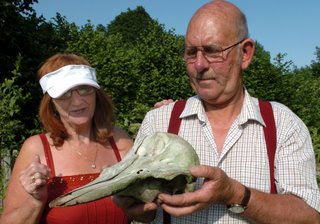These catfish are of particular interest to cryptozoologists because they illustrate how new species are found all the time, and will be part of the South American exhibit in the museum when it is finally built later in the year. The saga of the "L Numbered Catfish" is an interesting one.
As my colleague David Marshall wrote in issue 9 of Tropical World magazine:
"In the late 1980's a small variety of loricarins new to the U.K. aquarium hobby began appearing in aquatic retail outlets. All of these fish were given exotic-sounding common names so a small white fish with black stripes was sold as the emperor or zebra peckoltia, a fish with wavy black and yellow markings the scribbled plec, and one with a dark black body and white spots was sold as the vampire plec.
From the scant information that could be obtained, mainly through friendly retailers, U.K. aquarists were led to believe that all of these fish had originated from the Rio Xingu area of Brazil and were vegetarian by nature. It would take sometime for this information to be corrected, and make aquarists realise that these particular loricarins’ natural range extended beyond the Xingu area and that their dietary requirements were actually very varied.
As more of these loricarins began to appear, the sales tickets on their aquaria (first seen in Yorkshire through L 018 - Baryancistrus niveatus 'golden nugget') began to show a sequence that began with the letter L"
There are now dozens of these fish, all still awaiting categorisation. We hope that our exhibit will illustrate what is one of the most interesting developments in contemporary aquaculture. However, back to the story:
This morning, chaos reigned at the CFZ, and so we got Graham to storyboard the events so we can share our activities with you all out there in Internet-land....
 Helen arrives clutching a bucket containing four or five disgruntled catfish. Because tank space is at a premium here at the moment, she puts them into a sexagonal viv which we are reserving for treefrogs. Don't do this at home kids...
Helen arrives clutching a bucket containing four or five disgruntled catfish. Because tank space is at a premium here at the moment, she puts them into a sexagonal viv which we are reserving for treefrogs. Don't do this at home kids...
 This may look unfortunate, but it is the best way of transferring these hardy little fish
This may look unfortunate, but it is the best way of transferring these hardy little fish

The last fish in, we have two delightful (but unexpected) visitors.
 Ross and Greg stare, fascinated, at the armoured catfish
Ross and Greg stare, fascinated, at the armoured catfish

They may look a little cramped, but they are happy and healthy
 Mark North essembles a flat packed table for the tank to rest on
Mark North essembles a flat packed table for the tank to rest on
The kids help Mark and Helen get the equipment from the car. Ross demonstrates a firm grasp of the CFZ ethos..
It was only afterwards that Graham remarked that by happenstance both Mark and Helen were wearing almost identical clothes which made them look (or so he claimed) like a pair of deliverymen from B&Q
Helen enjoys a cigarette as she admires the aquarium she has gifted to the CFZ




